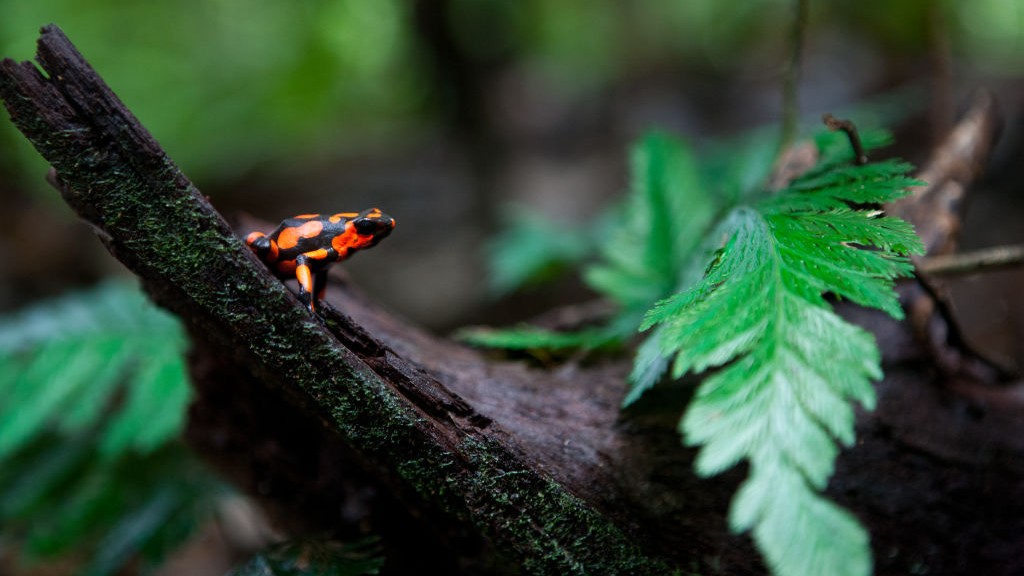Why don't poisonous animals die from their own toxins?
Poisonous animals have evolved a bag of tricks to avoid autointoxication.

Some of the most poisonous animals in the world are small, colorful frogs called poison dart frogs, in the family Dendrobatidae, which live in the rainforests of Central and South America. A single frog carries enough poison to kill 10 adult humans. Interestingly, these frogs aren't born poisonous — they acquire their poisonous chemical by eating insects and other arthropods.
But if this poison is so deadly, why do the frogs themselves not die when they ingest it?
These frogs' ability to avoid autointoxication has puzzled scientists for a long time, said Fayal Abderemane-Ali, a researcher at the University of California San Francisco's Cardiovascular Research Institute, and the lead author of a new study in the Journal of General Physiology that explores this phenomenon.
Related: What should you do if you're bitten by a venomous snake?
In the new paper, the researchers studied poison frogs in the genus Phyllobates that employ a toxin called batrachotoxin, which works by disrupting the transport of sodium ions in and out of cells — one of the most important physiological functions in the body. When your brain sends signals to the body, it sends them via electricity. These signals carry instructions to parts of the body, for example to your limbs to tell them to move, to muscles to tell them to contract, and to the heart to tell it to pump. These electrical signals are made possible by the flow of positively charged ions, such as sodium, into negatively charged cells. Ions flow in and out of cells via protein doors called ion channels. When these ion channels are disrupted, electrical signals can't travel through the body.
Batrachotoxin causes the ion channels to stay open, resulting in a freely-flowing stream of positively charged ions into cells, Abderemane-Ali told Live Science. If those are unable to close, the entire system loses its ability to transmit electrical signals.
"We need these channels to open and close to generate electricity that runs our brain or heart muscles," Abderemane-Ali said. If the channels just stay open, "there is no cardiac activity, there is no neuronal activity or contractive activity."
Get the world’s most fascinating discoveries delivered straight to your inbox.
Basically, if you ingest one of these frogs, you die — almost immediately.
So how do these frogs, and other poisonous animals, avoid suffering the same fate? There are three strategies poisonous animals use to stop autointoxication, Abderemane-Ali said. The most common involves a genetic mutation that slightly changes the shape of the toxin's target protein — the sodium-ion door — so that it can no longer bind to the protein. For example, a species of poison frog called Dendrobates tinctorius azureus carries a toxin called epibatidine that mimics a beneficial signaling chemical called acetylcholine. According to a 2017 study published in the journal Science, these frogs evolved adaptations in their acetylcholine receptors that slightly changed the shape of those receptors, making them resistant to the toxin.
Another strategy, used by predators of poisonous animals, is the ability to get rid of the toxin from the body entirely, Abderemane-Ali said. This process isn't necessarily the same as avoiding autointoxication, it's just another way that animals avoid being poisoned by things they eat.
The third strategy is called "sequestration."
"The animal will develop systems to capture [or] to soak up the toxin to make sure that it does not cause problems to the animal," Adberemane-Ali said.
In Adberemane-Ali's study, he cloned sodium-ion channels from Phyllobates frogs and treated them with the toxin. He was surprised to see that the sodium-ion channels were not resistant to the toxin.
"These animals should be dead," Abderemane-Ali said. Because the frogs' sodium-ion channels did not resist the toxin's disruptive effects, the frogs shouldn't be able to survive with this toxin in their bodies.
Based on those results, Abderemane-Ali suspects that these frogs are most likely employing the sequestration strategy of avoiding autointoxication by using something he calls a "protein sponge." The frogs likely produce a protein that can sop up the toxin and hold onto it, meaning the toxin never has a chance to reach those vulnerable protein channels in the first place.
American bullfrogs (Rana catesbeiana) also use sequestration, Abderemane-Ali said. These frogs produce a protein called saxiphilin, which can bind to and block the toxin saxitoxin. Saxiphilin is currently being studied as a potential solution to neutralize toxins introduced into our water supply by harmful algal blooms.
Originally published on Live Science.

JoAnna Wendel is a freelance science writer living in Portland, Oregon. She mainly covers Earth and planetary science but also loves the ocean, invertebrates, lichen and moss. JoAnna's work has appeared in Eos, Smithsonian Magazine, Knowable Magazine, Popular Science and more. JoAnna is also a science cartoonist and has published comics with Gizmodo, NASA, Science News for Students and more. She graduated from the University of Oregon with a degree in general sciences because she couldn't decide on her favorite area of science. In her spare time, JoAnna likes to hike, read, paint, do crossword puzzles and hang out with her cat, Pancake.



